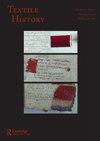编织联系:中世纪地中海的西西里丝绸
IF 0.1
2区 社会学
0 HUMANITIES, MULTIDISCIPLINARY
引用次数: 1
摘要
丝绸生产是伊斯兰西西里岛经济的一个重要方面,诺曼伯爵和当时的西西里国王都致力于维持这一经济。丝绸的生产与伊斯兰西西里岛的其他经济实践(如灌溉技术和土地利用)一起幸存下来。丝绸继续沿着地中海中部的贸易路线流动到12世纪。虽然这些联系在12世纪末被动乱和叛乱所破坏,但它们以某种形式一直存在到13世纪中期。只有将穆斯林驱逐出西西里岛,才结束了这些联系。本文章由计算机程序翻译,如有差异,请以英文原文为准。
Weaving Connections: Sicilian Silk in the Medieval Mediterranean
The production of silk was an important aspect of the economy of Islamic Sicily that the Norman count and then kings of Sicily worked to maintain. The production of silk survived along with other economic practices of Islamic Sicily, such as irrigation techniques and land use. Silk continued to move along the trade routes of the Central Mediterranean into the twelfth century. While those connections were disrupted by unrest and revolt at the end of the twelfth century, they survived in some form until the mid-thirteenth century. It was only the expulsion of Muslims from Sicily that ended these connections.
求助全文
通过发布文献求助,成功后即可免费获取论文全文。
去求助
来源期刊

TEXTILE HISTORY
HUMANITIES, MULTIDISCIPLINARY-
CiteScore
1.00
自引率
0.00%
发文量
0
期刊介绍:
Textile History is an internationally recognised, peer reviewed journal and one of the leading publications in its field. It is viewed as an important outlet for current research. Published in the spring and autumn of each year, its remit has always been to facilitate the publication of high-quality research and discussion in all aspects of scholarship arising from the history of textiles and dress. Since its foundation the scope of the journal has been substantially expanded to include articles dealing with aspects of the cultural and social history of apparel and textiles, as well as issues arising from the exhibition, preservation and interpretation of historic textiles or clothing.
 求助内容:
求助内容: 应助结果提醒方式:
应助结果提醒方式:


